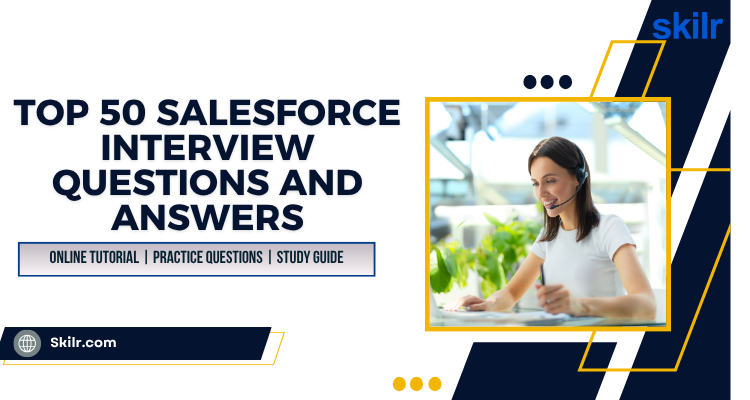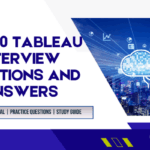Salesforce is the world’s leading Customer Relationship Management (CRM) platform, widely adopted by businesses to manage customer data, automate processes, and drive intelligent decision-making. From sales and marketing to service and app development, Salesforce offers a robust suite of tools that streamline operations across departments.
Given its widespread use, professionals skilled in Salesforce—whether as administrators, developers, or consultants—are in high demand. Interviewers look for candidates who not only understand the basics of the platform but can also demonstrate hands-on expertise in solving real-world problems using Salesforce tools and features.
This blog presents a carefully curated list of the top 50 Salesforce interview questions and answers, designed to help you prepare effectively. Whether you are a fresher starting your career, a certified professional seeking a role upgrade, or someone switching into the Salesforce ecosystem, this guide will give you the clarity and confidence to perform well in interviews.
Who Should Read This Blog?
This blog is crafted for a wide range of professionals and aspirants in the Salesforce ecosystem. Whether you are new to the platform or looking to refine your expertise before an interview, this guide will support your preparation with relevant and practical insights.
You should read this blog if you are:
- A fresher or recent graduate aiming to start a career in CRM or Salesforce consulting
- A certified Salesforce Administrator or Developer preparing for job interviews
- An IT professional transitioning into a Salesforce-based role
- A business analyst or consultant who works closely with Salesforce teams
- A Trailhead learner or self-taught enthusiast seeking structured revision before certification exams
The questions are arranged by difficulty to suit readers at various experience levels—starting from foundational topics and progressing to advanced scenarios and practical challenges.
Top 50 Salesforce Interview Questions and Answers
Salesforce interviews test both your theoretical understanding and your ability to apply platform features to real-world business needs. To help you prepare efficiently, we have categorized the questions into different difficulty levels—starting with foundational concepts and moving towards more technical and scenario-based questions.
Let us begin with the Basic-Level Questions to build a strong foundation.
Basic-Level Salesforce Interview Questions (1–15)
1. What is Salesforce?
Answer:
Salesforce is a cloud-based Customer Relationship Management (CRM) platform that allows businesses to manage relationships with customers, streamline operations, and drive growth using tools for sales, service, marketing, analytics, and app development.
2. What are Standard and Custom Objects in Salesforce?
Answer:
- Standard Objects are pre-built objects provided by Salesforce, such as Leads, Accounts, Contacts, and Opportunities.
- Custom Objects are user-defined objects that store information unique to an organization.
3. What is a Record in Salesforce?
Answer:
A record is a single instance of an object. For example, one customer in the Contact object or one deal in the Opportunity object.
4. What is the difference between Salesforce Classic and Lightning Experience?
Answer:
- Salesforce Classic is the older user interface.
- Lightning Experience is the modern UI with enhanced functionality, responsive design, and component-based architecture.
5. What is an App in Salesforce?
Answer:
An app is a collection of tabs, objects, and functionality in Salesforce grouped together for a specific business purpose. Users can switch between apps using the App Launcher.
6. What is a Tab in Salesforce?
Answer:
A tab represents an object and allows users to access records related to that object. For example, the “Accounts” tab opens the Account object and its records.
7. What are Fields in Salesforce?
Answer:
Fields are individual data points within an object. They define the type of data stored, such as text, number, date, or lookup (relationship to another object).
8. What is a Relationship in Salesforce?
Answer:
A relationship is a way to link two objects. There are three main types:
- Lookup Relationship
- Master-Detail Relationship
- Many-to-Many (via junction object)
9. What is a Page Layout?
Answer:
A page layout controls the organization and visibility of fields, sections, and related lists on a record detail page. It allows customization for different profiles.
10. What is a Validation Rule?
Answer:
A validation rule ensures data quality by preventing users from saving records that do not meet specified criteria. It uses a formula to return true or false.
11. What is a Workflow Rule?
Answer:
A workflow rule automates standard internal processes by triggering actions such as email alerts, task creation, or field updates based on criteria evaluation.
12. What is the AppExchange?
Answer:
AppExchange is Salesforce’s online marketplace for third-party apps, components, and consulting services that can be installed to extend platform functionality.
13. What is a Profile in Salesforce?
Answer:
A profile defines what users can see and do in Salesforce. It controls access to objects, fields, records, tabs, and system features.
14. What is a Role in Salesforce?
Answer:
A role determines a user’s position in the organization hierarchy and controls record-level access through role-based sharing.
15. What is the difference between a Profile and a Role?
Answer:
- Profile controls object-level permissions and system access
- Role controls record-level access and visibility within the data hierarchy
Intermediate-Level Salesforce Interview Questions (16–30)
16. What is a Lookup Relationship in Salesforce?
Answer:
A Lookup Relationship creates a loosely coupled link between two objects. It allows one object to reference another, but the child record can exist independently of the parent.
17. What is a Master-Detail Relationship?
Answer:
A Master-Detail Relationship creates a tightly coupled link between two objects. The child record is dependent on the parent and inherits its sharing and deletion behavior.
18. What is a Junction Object?
Answer:
A Junction Object is a custom object used to create a many-to-many relationship between two other objects by establishing two master-detail relationships.
19. What are Record Types in Salesforce?
Answer:
Record Types allow you to offer different page layouts, picklist values, and business processes to different users based on their profiles.
20. What is a Permission Set?
Answer:
A Permission Set is a collection of permissions that can be assigned to users to grant additional access beyond their profile limitations, without changing the profile.
21. What is a Sharing Rule?
Answer:
A Sharing Rule is used to extend record-level access to users in roles, public groups, or territories. It overrides organization-wide defaults to grant broader access.
22. What are Formula Fields?
Answer:
Formula Fields are read-only fields that automatically calculate values using expressions and return results based on other fields in the same object or related objects.
23. What is a Roll-Up Summary Field?
Answer:
A Roll-Up Summary Field aggregates values (SUM, MIN, MAX, COUNT) from related child records in a master-detail relationship and displays the result on the parent record.
24. What are Validation Rule components?
Answer:
Validation Rules consist of:
- Rule logic (formula): Evaluates to
trueorfalse - Error message: Displayed when the condition is met
- Location: Field-specific or record-wide
25. What are the different types of Reports in Salesforce?
Answer:
Salesforce supports:
- Tabular Reports – Simple list
- Summary Reports – Grouped rows
- Matrix Reports – Grouped by rows and columns
- Joined Reports – Multiple views side by side
26. What are Dashboards in Salesforce?
Answer:
Dashboards are visual representations of reports. They use components like charts, tables, and gauges to provide a real-time view of key metrics.
27. What is the difference between Workflow and Process Builder?
Answer:
- Workflow supports simple if/then logic for a limited set of actions
- Process Builder offers a more visual and powerful tool with multiple conditions, actions, and object support
28. What is a Sandbox in Salesforce?
Answer:
A Sandbox is a copy of the production environment used for development, testing, and training without affecting live data. Types include Developer, Developer Pro, Partial Copy, and Full Sandbox.
29. What is the Governor Limit in Salesforce?
Answer:
Governor Limits are runtime limits imposed by Salesforce to ensure shared resource usage. These include limits on CPU time, number of queries, DML operations, and more.
30. What is a Custom Metadata Type?
Answer:
Custom Metadata Types allow you to define application configurations and settings that can be deployed between orgs and accessed in formulas, flows, and Apex without hardcoding.
Advanced-Level Salesforce Interview Questions (31–40)
31. What is Apex in Salesforce?
Answer:
Apex is a strongly typed, object-oriented programming language used in Salesforce for building custom business logic. It is similar to Java and is executed on the Salesforce platform.
32. What is a Trigger in Salesforce?
Answer:
A Trigger is an Apex script that executes before or after specific data manipulation language (DML) events, such as insert, update, delete, or undelete, on a Salesforce object.
33. What is the difference between a Before Trigger and an After Trigger?
Answer:
- Before Triggers are used to validate or update values before data is saved to the database.
- After Triggers are used to access field values (including auto-generated IDs) and perform actions that require record IDs.
34. What is SOQL in Salesforce?
Answer:
SOQL (Salesforce Object Query Language) is used to retrieve records from Salesforce objects. It is similar to SQL but designed specifically for Salesforce’s data model.
35. What is SOSL in Salesforce?
Answer:
SOSL (Salesforce Object Search Language) is used to perform text-based searches across multiple objects and fields. Unlike SOQL, it returns records that match search terms in any searchable field.
36. What are Governor Limits in Apex?
Answer:
Governor Limits are runtime limits set by Salesforce to maintain shared resource fairness. Examples include:
- Max 100 SOQL queries per transaction
- Max 150 DML operations per transaction
- Max 10MB heap size
37. What is a Batch Apex?
Answer:
Batch Apex is used to process large volumes of records asynchronously in manageable chunks. It implements the Database.Batchable interface and executes in three steps: start, execute, and finish.
38. What is a Queueable Apex?
Answer:
Queueable Apex allows you to chain jobs and execute complex logic asynchronously. It is more flexible than future methods and supports monitoring and job chaining.
39. What is Future Apex and when should it be used?
Answer:
Future methods run asynchronously in the background. They are useful for operations like callouts, DML operations on large data sets, or long-running tasks that do not require immediate completion.
40. What is a Custom Setting in Salesforce? How is it different from Custom Metadata?
Answer:
Custom Settings are similar to Custom Objects and store static data that can be accessed without DML. Unlike Custom Metadata, they are not deployable between environments via packages or changesets.
Scenario-Based Salesforce Interview Questions (41–50)
41. A user is unable to see a record they created. What could be the issue?
Answer:
Possible reasons include:
- The object has Private organization-wide default (OWD) settings
- The user’s role hierarchy does not allow upward visibility
- No sharing rules or manual sharing has been applied
- The record may be owned by another user or reassigned by automation
42. How would you design a system to prevent duplicate leads from being created?
Answer:
- Use matching rules and duplicate rules to compare new leads with existing ones
- Implement a before insert trigger or a validation rule for custom matching logic
- Enable reporting to identify and merge existing duplicates
43. How would you handle a requirement to send an approval request when a deal is over $50,000?
Answer:
- Create an Approval Process with an entry condition:
Opportunity.Amount > 50000 - Assign approvers via user lookup, manager field, or a role
- Configure actions (email alerts, field updates) based on approval or rejection
44. How can you give access to a specific report folder to a group of users without changing profiles?
Answer:
- Create a Public Group
- Share the report folder with that group
- No need to modify profiles or roles
45. A manager wants to view all activities of their team without seeing all records. How do you configure this?
Answer:
- Use role hierarchy to allow the manager to view related tasks and events
- Use field-level security or sharing rules to limit visibility to parent records
- Optionally use custom reports with filters scoped to “My Team’s Activities”
46. How would you create a dynamic picklist based on another field’s value?
Answer:
- Use dependent picklists where the controlling field determines the available options in the dependent field
- Configure via field dependencies in object settings
47. How do you migrate metadata between sandbox and production?
Answer:
- Use Change Sets for metadata deployment
- For advanced control, use Salesforce CLI (SFDX) or ANT Migration Tool
- Always validate in a Full Sandbox before production deployment
48. How would you display different page layouts for users in different departments?
Answer:
- Create multiple Record Types
- Assign different page layouts to each Record Type
- Map Record Types to specific profiles
49. How would you design a custom object to track employee certifications across departments?
Answer:
- Create a Certification custom object
- Create a lookup relationship to User or Employee object
- Add fields such as Certification Name, Date, Expiry
- Use reports and dashboards to monitor renewals or expiries
50. A client wants to integrate Salesforce with an external ERP system. How would you approach this?
Answer:
- Determine the data flow: real-time (REST API) or batch (ETL tools)
- Use Outbound Messaging, Platform Events, or Apex Callouts
- For bi-directional sync, use Middleware like MuleSoft or Dell Boomi
- Ensure proper authentication, rate limits, and error handling
Core Salesforce Concepts to Revise Before an Interview
To perform well in a Salesforce interview, you must go beyond memorizing definitions and focus on understanding how features are applied in real scenarios. Below are the essential areas you should revise before stepping into an interview:
1. Salesforce Data Model
- Standard vs. Custom Objects
- Record Types, Page Layouts, and Field Types
- Relationships: Lookup, Master-Detail, and Junction Objects
- Schema Builder
2. Security and Access Control
- Profiles vs. Roles
- Permission Sets and Permission Set Groups
- Field-Level Security (FLS)
- Organization-Wide Defaults (OWD), Sharing Rules, Manual Sharing
- Login IP Ranges and Login Hours
3. Automation Tools
- Workflow Rules
- Process Builder
- Flow (Screen, Record-Triggered, Scheduled)
- Approval Processes
- When to use Declarative vs. Programmatic Automation
4. Apex and Development Essentials
- Triggers: Before/After, Recursive Prevention
- SOQL vs. SOSL
- Governor Limits and Best Practices
- Apex Classes, Interfaces, and Batch Apex
- Future Methods, Queueable Apex
5. Reporting and Dashboards
- Report Types (Tabular, Summary, Matrix, Joined)
- Dashboards and Filters
- Report Subscriptions and Scheduling
- Custom Report Types
6. Deployment and Environments
- Sandboxes (Developer, Partial Copy, Full)
- Change Sets
- Metadata API, ANT Migration Tool, Salesforce CLI
- Version control using Git (if applicable)
7. AppExchange and Integrations
- Installing and configuring apps from AppExchange
- REST and SOAP APIs
- Connected Apps and Named Credentials
- External Objects and Salesforce Connect
8. Lightning Experience
- Lightning Components (Aura vs. LWC)
- Lightning App Builder
- Lightning Pages and Record Pages
- Component Visibility Rules
9. Salesforce Releases and Best Practices
- Stay updated with Salesforce’s triannual releases
- Understand new features and deprecated tools
- Follow Salesforce’s design patterns and security practices
10. Certifications and Trailhead
- Be familiar with your certification paths (Admin, Platform Developer, App Builder, etc.)
- Use Trailhead badges to demonstrate continuous learning
Conclusion
Salesforce remains one of the most sought-after platforms in the world of customer relationship management and enterprise application development. As businesses increasingly depend on automation, customer intelligence, and cloud platforms, professionals with Salesforce expertise continue to be in high demand.
With consistent learning and preparation, you will be well-positioned to impress recruiters and hiring managers alike.





